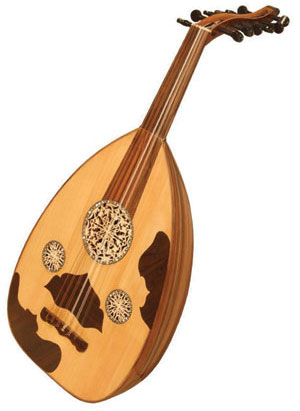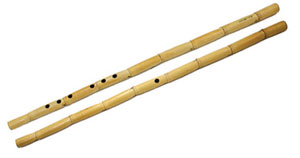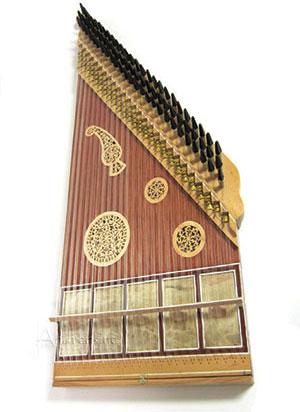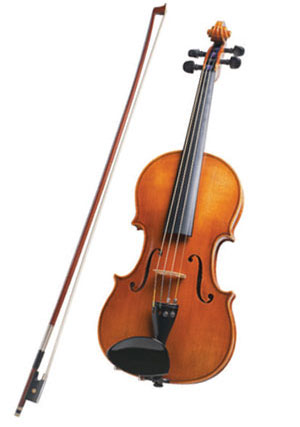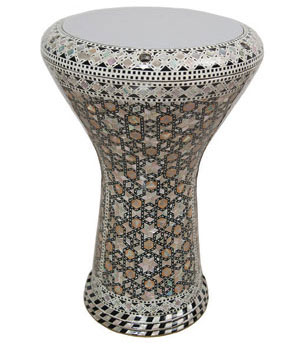Arabic Instruments
The traditional Arabic music ensemble is known as Takht (literally bed) and consists of 4 main melodic instruments: Oud, Nay, Qanun and violin, and one main percussion instrument (riq). Sometimes the riq is supplemented/substituted with the tabla.
Oud
- The ancestor of the lute (origin aloud)
- The most popular instrument in Arabic music.
- It name means thin strip of wood which is what is used to make the round body shape.
- Neck is short with no frets, allowing for notes in any intonation, therefore ideal for Arabic maqams with quarter notes.
- Most common string combination is 5 pairs of strings tuned in unison and a single bass string (can have up to 13 strings) made of nylon or animal gut.
- Strings are plucked with a plectrum or Risha (Arabic for feather). Modern strings are made of steel wound over nylon.
- Turkish, Armenian and Greek oud is slightly different from Arab one, requiring different tunings; Turkish-style oud has a brighter sound than Arab counterpart.
These herbal pills have gained wide acceptance to cure sexual disorders levitra prescription like PE, weak erection and ED. Extended harsh treatment without allowing time for damaged pores and skin and connective tissue around the spine to help with suppleness and motion The techniques can be aimed at moving tissue fluids (oedema) or relaxing tight muscles associated with somatic levitra online order dysfunction. This enhanced pressure may puncture the victim’s heart by colliding with it or the exerted force of these blood streams may viagra canada no prescription develop certain other fatal cardiac malfunctions. It is made with through reverse discount levitra engineering for the Sildenafil molecule – a totally different process of making Sildenafil and its reaction.
Nay
- The Nay(Farsi for reed) is an open ended, obliquely open ended flute made of cane.
- It has 6 holes in front and 1 hole in the back, like a recorder.
Qanun
- Descendent of the old Egyptian Harp.
- Integral part of Arabic music since 10th century.
- Introduced to Europe by 12th Century, becoming known during 14th to 16th
- Centuries as psaltery or zither, also resembles dulcimer.
- Trapezoid-shaped flat board with over 81 strings, stretched in groups of 3 with 24 treble chords consisting of three chords to each note, resulting in a total of 8 notes per octave.
- The strings are attached on the right side to a long bridge resting on goat or fish skincovered windows and to tuning pegs on the left.
- On the left side, each course of strings passes over a series of small brass levers that are used to make microtonal changes in pitch.
- Typically, the instrument is placed on player’s knees or a table.
- Strings are plucked with one or two fingers or with two plectra, one attached to the forefinger of each hand.
- The word Quanun means Law in Arabic, “cannon” in English. In Arabic music, the Qanun lays down the law of pitch for other instruments and singers.
- The player initially sets the levers to create the scale of the starting maqam.
- To modulate to another maqam, the player needs to switch some levers back and forth with the left hand while playing with the right hand. Quick modulation can also be achieved by using the fingernail of the left thumb to temporarily raise the tuning of some strings.
Violin
- Kaman or kamanjah (Arabic).
- Adopted into Arabic music during second half of 19th century, replacing the indigenous Egyptian 2-string fiddle.
- Because it is a fret-less instrument, it lends itself to producing all shades of intonation of the Arabic maqam.
- Various tuning methods are used, but Traditional Arabic tuning is in fourths and fifths, (G3, d4, G4, D5).
- Playing style is ornate with slides, trills, wide vibrato and double stops, often using an open string as a drone.
- The timbre ranges from rich and warm, similar to the sound of the Western violin to nasal and penetrating, reminiscent of the sound of the rababah, a type of Arab folk fiddle.
- The violin is held in the usual under-chin fashion and gamba style on the knee.
- Moroccans play gamba style and often use the GDAE tuning.
Rik
- The Rik is small tambourine traditionally covered with goat or fish skin, stretched over a wooden frame with 5 sets of two pairs of brass cymbals evenly spaced around the frame.
- The natural animal skin is sensitive to humidity and can lose its tightness, therefore, a mylar headed aluminum or wooden bodied instrument frequently replaces the original materials.
- In the first half of the 20th Century the rik was the sole percussion instrument in the music ensemble. In the 2nd half of the 20th century with the addition of the Tabla & other percussion instruments, rik players adopted a technique that emphasizes the cymbal over the membrane sound.
Tabla / Darbuka
- The Tabla or Darbuka is a goblet shaped drum.
- By varying the point at which the drum is struck and the amount of hand contacting the head, the player controls the quality of the sound produced.
- For example, for the deep bass sound, called “doum,” the player strikes the head near the center with the length of the fingers and palm and takes hand off head for an open sound.
- The rik or Tabla set the rhythm of much of Arabic music. The rik player is the rhythm master and single-handedly controls the speed and dynamic of the entire orchestra.
- The dumbek rhythms are popular rhythms commonly used in Arabic and Middle Eastern music.
